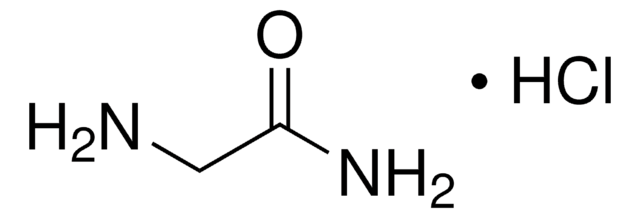8.22336
Thioglycolic acid
for synthesis
Sinónimos:
Thioglycolic acid, Mercaptoacetic acid, 2-Mercaptoethanoic acid
About This Item
Productos recomendados
vapor pressure
0.1 hPa ( 20 °C)
Quality Level
form
liquid
potency
73 mg/kg LD50, oral (Rat)
pH
1 (20 °C in H2O)
bp
220 °C/1013 hPa (decomposition)
mp
-16.5 °C
transition temp
flash point 131.5 °C
density
1.325 g/cm3 at 20 °C
storage temp.
2-8°C
InChI
1S/C2H4O2S/c3-2(4)1-5/h5H,1H2,(H,3,4)
InChI key
CWERGRDVMFNCDR-UHFFFAOYSA-N
Application
- Biocompatible Drug Delivery Films: Thioglycolic acid enhances the film-forming ability and bioadhesiveness of mucilaginous polysaccharides derived from Cassia uniflora seeds. This innovation is pivotal in drug delivery applications, offering controlled release and improved mucosal adhesion properties (Deore et al., 2024).
- Surface Plasmon Resonance in Nanoparticle Research: The interfacial reactivity of gold nanoparticles can be inferred via surface plasmon resonance measurements, with thioglycolic acid playing a crucial role in modifying nanoparticle surfaces to enhance their reactive properties. This is significant for advancements in nanotechnology and material sciences (Romain et al., 2023).
- Enhanced SERS for Virus Detection: Thioglycolic acid contributes to the fabrication of flexible electrospinning nano-fiber membranes that are pivotal in the detection of respiratory tract transmission viruses using Surface Enhanced Raman Scattering (SERS). This application is crucial in improving public health surveillance and response systems (Sun et al., 2024).
Analysis Note
Density (d 20 °C/ 4 °C): 1.325 - 1.335
Identity (IR): passes test
The assay stated on the certificate of analysis refers to the date of examination. A gradual substance-specific content reduction, especially at higher temperatures, must be expected. The average content reduction at the required storage temperature of +2°c to +8°C is about 1% per month.
signalword
Danger
Hazard Classifications
Acute Tox. 3 Dermal - Acute Tox. 3 Inhalation - Acute Tox. 3 Oral - Eye Dam. 1 - Skin Corr. 1B - Skin Sens. 1B
Storage Class
6.1C - Combustible, acute toxic Cat.3 / toxic compounds or compounds which causing chronic effects
wgk_germany
WGK 1
flash_point_f
266.0 °F - closed cup
flash_point_c
130 °C - closed cup
Certificados de análisis (COA)
Busque Certificados de análisis (COA) introduciendo el número de lote del producto. Los números de lote se encuentran en la etiqueta del producto después de las palabras «Lot» o «Batch»
¿Ya tiene este producto?
Encuentre la documentación para los productos que ha comprado recientemente en la Biblioteca de documentos.
Los clientes también vieron
Nuestro equipo de científicos tiene experiencia en todas las áreas de investigación: Ciencias de la vida, Ciencia de los materiales, Síntesis química, Cromatografía, Analítica y muchas otras.
Póngase en contacto con el Servicio técnico















